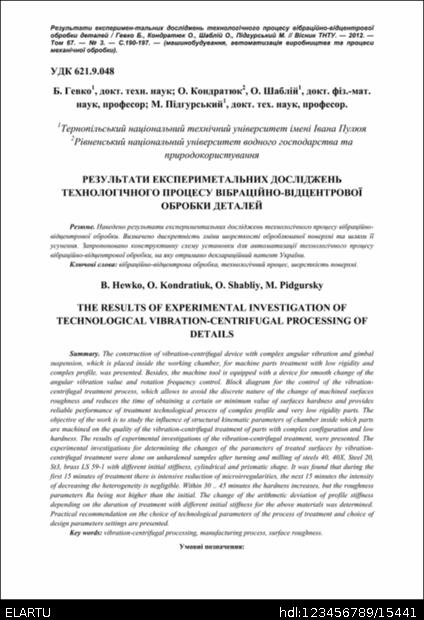Παρακαλώ χρησιμοποιήστε αυτό το αναγνωριστικό για να παραπέμψετε ή να δημιουργήσετε σύνδεσμο προς αυτό το τεκμήριο:
http://elartu.tntu.edu.ua/handle/123456789/15441

| Title: | Результати експериметальних досліджень технологічного процесу вібраційно-відцентрової обробки деталей |
| Other Titles: | The results of experimental investigation of technological vibration-centrifugal processing of details |
| Authors: | Гевко, Б. Кондратюк, О. Шаблій, О. Підгурський, М. Hewko, B. Kondratiuk, O. Shabliy, O. Pidgursky, M. |
| Affiliation: | Тернопільський національний технічний університет імені Івана Пулюя Рівненський національний університет водного господарства та природокористування |
| Bibliographic description (Ukraine): | Результати експеримен-тальних досліджень технологічного процесу вібраційно-відцентрової обробки деталей / Гевко Б., Кондратюк О., Шаблій О., Підгурський М. // Вісник ТНТУ. — 2012. — Том 67. — № 3. — С.190-197. — (машинобудування, автоматизація виробництва та процеси механічної обробки). |
| Journal/Collection: | Вісник Тернопільського національного технічного університету |
| Issue: | 3 |
| Volume: | 67 |
| Issue Date: | 22-Μαρ-2012 |
| Date of entry: | 31-Μαρ-2016 |
| Publisher: | Тернопільський національний технічний університет ім. Івана Пулюя |
| Place of the edition/event: | Тернопіль, Україна |
| UDC: | 621.9.048 |
| Keywords: | вібраційно-відцентрова обробка технологічний процес шорсткість поверхні vibration-centrifugal processing manufacturing process surface roughness |
| Number of pages: | 8 |
| Start page: | 190 |
| End page: | 197 |
| Abstract: | Наведено результати експериментальних досліджень технологічного процесу вібраційно-відцентрової обробки. Визначено дискретність зміни шорсткості оброблюваної поверхні та шляхи її усунення. Запропоновано конструктивну схему установки для автоматизації технологічного процесу вібраційно-відцентрової обробки, на яку отримано деклараційний патент України. The construction of vibration-centrifugal device with complex angular vibration and gimbal suspension, which is placed inside the working chamber, for machine parts treatment with low rigidity and complex profile, was presented. Besides, the machine tool is equipped with a device for smooth change of the angular vibration value and rotation frequency control. Block diagram for the control of the vibration-centrifugal treatment process, which allows to avoid the discrete nature of the change of machined surfaces roughness and reduces the time of obtaining a certain or minimum value of surfaces hardness and provides reliable performance of treatment technological process of complex profile and very low rigidity parts. The objective of the work is to study the influence of structural kinematic parameters of chamber inside which parts are machined on the quality of the vibration-centrifugal treatment of parts with complex configuration and low hardness. The results of experimental investigations of the vibration-centrifugal treatment, were presented. The experimental investigations for determining the changes of the parameters of treated surfaces by vibration-centrifugal treatment were done on unhardened samples after turning and milling of steels 40, 40X, Steel 20, St3, brass LS 59-1 with different initial stiffness, cylindrical and prismatic shape. It was found that during the first 15 minutes of treatment there is intensive reduction of microirregularities, the next 15 minutes the intensity of decreasing the heterogeneity is negligible. Within 30 .. 45 minutes the hardness increases, but the roughness parameters Ra being not higher than the initial. The change of the arithmetic deviation of profile stiffness depending on the duration of treatment with different initial stiffness for the above materials was determined. Practical recommendation on the choice of technological parameters of the process of treatment and choice of design parameters settings are presented. |
| URI: | http://elartu.tntu.edu.ua/handle/123456789/15441 |
| ISSN: | 1727-7108 |
| Copyright owner: | © „Вісник Тернопільського національного технічного університету“ |
| Publications status : | Опубліковано раніше |
| Content type: | Article |
| Εμφανίζεται στις συλλογές: | Вісник ТНТУ, 2012, № 3 (67) |
Αρχεία σε αυτό το τεκμήριο:
| Αρχείο | Περιγραφή | Μέγεθος | Μορφότυπος | |
|---|---|---|---|---|
| TNTUB_2012_v67_No3-Hewko_B_Kondratyuk_O_Shabliy_O-Results_of_experimental_studies_of__190.djvu | 448,59 kB | DjVu | Δείτε/ Ανοίξτε | |
| TNTUB_2012_v67_No3-Hewko_B_Kondratyuk_O_Shabliy_O-Results_of_experimental_studies_of__190.pdf | 305,66 kB | Adobe PDF | Δείτε/ Ανοίξτε | |
| TNTUB_2012_v67_No3-Hewko_B_Kondratyuk_O_Shabliy_O-Results_of_experimental_studies_of_190__COVER.png | 390,83 kB | image/png | Δείτε/ Ανοίξτε |
Όλα τα τεκμήρια του δικτυακού τόπου προστατεύονται από πνευματικά δικαιώματα